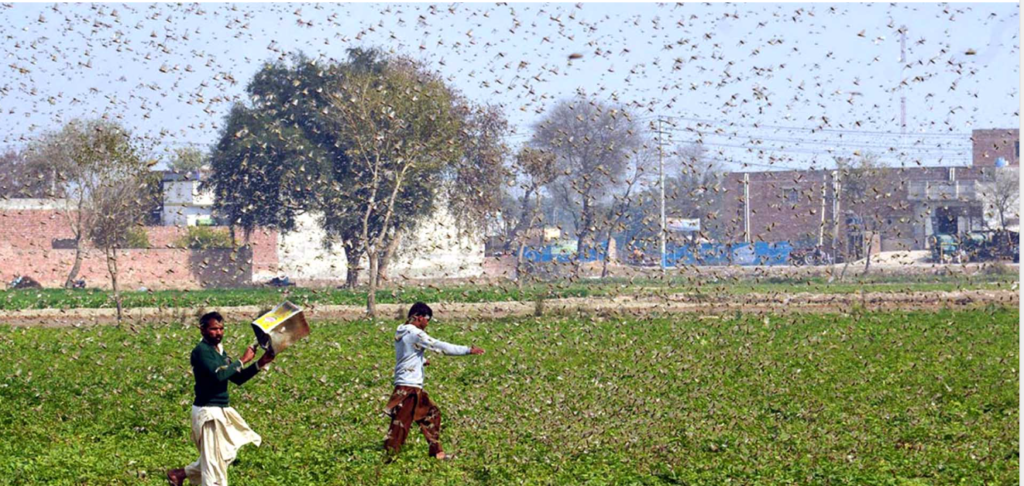Spotted locusts invade farms in Idukki, destroy crops (Prelims- Environment)

Locusts are the short-horned grasshoppers with highly migratory habit, marked polymorphism and voracious feeding behavior.
- They are capable of forming swarms (adult’s congregation) and hopper bands (nymphal congregation).
- They are indeed the sleeping giants that can flare up any time to inflict heavy damage to the crops leading to national emergency of food and fodder.
Only four species viz. Desert locust (Schistocerca gregaria), Migratory locust (Locusta migratoria), Bombay Locust ( Nomadacris succincta) and Tree locust (Anacridium sp.) are found in India.
- The desert locust is most important pest species in India as well as in intercontinental context.

This trans-border pest usually enters the scheduled desert areas of India from Africa, Gulf and Southwest Asia via Pakistan just ahead of the monsoon season for summer breeding and then returns around October and November towards Iran, Gulf and Africa for spring breeding.
About Desert Locust
- Desert Locusts are about 2 inches (5 centimeters) long in size and have short, thick antennas.
- Due to climatic changes, they reproduce so quickly in large numbers and become crowd.
- They behave differently in crowds and start forming into swarms. Without any break, they fly for days or weeks over thousands of miles. When they finally stop, each locust can intake more food than its body weight.
The desert locust is an international pest affecting about 60 countries, mainly:
India, Pakistan, Afghanistan, Arabia, Persia, Iraq and Africa.
- It is known to migrate in swarms from one country to another leaving behind famine.
- Adult locust swarms can fly up to 150 km (93 miles) a day with the wind and adult insects can consume roughly their own weight of fresh food per day.
- A very small swarm eats about as much food as 35,000 people eat in a day.
Major Incursion of locust swarm in India are:-
- During1926-31,1940-46,1949-55 and the last locust cycle in India was during 1959-62.
- Although no locust plague cycles have been observed after 1962. However, during 1978 and 1993, large scale locust upsurges were reported.
- In addition to the above, 276 Nos. of desert locust swarms during the year 2019 & 103 Nos. during 2020 (up to August, 2020) were noticed after a lap of more than 26 years after 1993.
- Major damage to agriculture crops in Rajasthan and Gujarat state was reported during 2019 for which government has granted compensation to the affected farmers.
During the year 2020 there were no crop loss reported till August, 2020 due to the cumulative efforts of Locust Warning Organization, Regional and International Organizations established to prevent plague under the overall coordination of the Food and Agriculture Organization.
Aiming to real time reporting of desert locust infestation android Mobile based application “eLocust3m” was implemented during 2020, which results an effective desert locust control.
Strategies for locust control
In India more than 2 lakh square kilometers area comes under Scheduled Desert Area.
Locust Warning Organization and 10 Locust Circle Offices (LCO) of Government of India are situated in Rajasthan and Gujarat are responsible for monitoring, survey and control of Desert Locust in Scheduled Desert Area in coordination with State Governments.
The chief aim of locust control is to destroy the locust in all its’ stages.
- Destruction of eggs
- Locating the egg laid areas is always important, then trench them round (2’ x 2’), so as to entrap the young hoppers as they move out after hatching and burying.
- Even actual destruction of eggs on organized scale may be carried out by ploughing, harrowing and hand digging
- Controlling flying locusts
When flying locusts are about to descend in large swarms in cultivated areas, the best way to handle them by all possible methods, such as :- Beating plates to create sound, or creating a cloud of smoke by burning refuse, etc.,
- Spraying with neem kernel suspension.
- “Duck troops” can counter locust attack. Each duck can eat as many as 200 locusts per day.
- Foliar spray with lambda cyhalothrin 5EC@400ml/ha or fipronil 5SC @125ml/ha on moong.
- Aerial sprays using drones with chemical pesticides like Malathion


